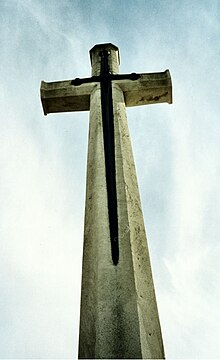This is an old revision of this page, as edited by Redvers (talk | contribs) at 21:44, 16 June 2006 (Changed image). The present address (URL) is a permanent link to this revision, which may differ significantly from the current revision.
Revision as of 21:44, 16 June 2006 by Redvers (talk | contribs) (Changed image)(diff) ← Previous revision | Latest revision (diff) | Newer revision → (diff)
The Commonwealth War Graves Commission is a joint governmental organisation responsible for marking and maintaining the graves of members of the Commonwealth military forces who died in the two world wars and subsequent wars, to build memorials to those with no known grave, and to keep records of the war dead. The Commission is responsible for the commemoration of 1.7 million Commonwealth servicemen and women in 150 countries worldwide.
Member nations are: the United Kingdom, Canada, Australia, New Zealand, South Africa, and India. Newfoundland was a founding member but ceased to have separate status from 1949 when it became a part of Canada. The President of the Commonwealth War Graves Commission is HRH The Duke of Kent.
The largest cemeteries are in France and Belgium built after the First World War. The largest Commonwealth War Graves Cemetery is Tyne Cot Cemetery north of Ypres, containing nearly 12,000 graves. A number of cemeteries are also present in the Middle East and Iraq as a result of battles against the Ottoman Empire during the First World War, and in North Africa and Italy from the Second World War. The cemeteries have always been respected as humanitarian, non-political sites and instances of vandalism or desecration are rare. On May 9, 2004, 33 headstones were demolished by three armed men in the Gaza War Cemetery (which contains 3,500 graves) in supposed retaliation for the notorious Abu Ghraib prisoner abuse.
Each cemetery is made up of rows of white gravestones -- unlike French or German graves these are not shaped like crosses but are rather rectangles with rounded tops. Each gravestone is marked with a cross, however, except for those where the dead were known to belong to another religion where another symbol is provided. The graves are also marked with the name, rank and unit symbol of the soldier. Many soldiers are unknown and their gravestones bear no name, these have the phrase "Known Unto God" engraved upon them. Some graves also have additional phrases added by friends or family.

The cemeteries are normally surrounded by a low brick wall often with a decorative gate over the entrance. Many have an identical war memorial called the Cross of Sacrifice designed by Sir Reginald Blomfield that vary in height from 4.5m to 9m depending on the size of the cemetery. If there are one thousand or more burials, a Commonwealth cemetery will contain a Stone of Remembrance, designed by Sir Edwin Lutyens with words from the book of Ecclesiasticus "THEIR NAME LIVETH FOR EVERMORE", all the Stones of Remembrance are all 3.5m long and 1.5m high with three steps leading up to them. Each cemetery has a plaque that explains which war the soldiers died in and provides some background history. They also have a visitors book and a register of everyone buried in the cemetery.

On the Gallipoli Peninsula, and at the Haidar Pasha Cemetery in Istanbul, the cemeteries have slightly different design features. To prevent masonary sinking into water-sodden ground, the graves have stone-faced pedestal markers rather than headstones, and instead of a freestanding Cross of Sacrifice, the cross is built into a wall.
Some of the Monuments and Cemeteries Maintained by the CWGC
- the 3 cemeteries on the Death Railway
- the Kranji War Memorial and Cemetery in Singapore
- The Ottawa Memorial in Ottawa, Canada
- cemeteries in Hong Kong at Sai Wan, and at Stanley in the Falkland Islands
References
External links
- Commonwealth War Graves Commission homepage
- For King and Empire
- British War Memorial Project
- Maple Leaf Legacy Project
- Australian War Grave Photographic Archive
- South Africa War Graves Project
- United Kingdom National Index of War Memorial
- http://collections.ic.gc.ca/courage/wargravescommission.html